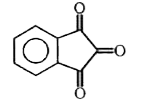Which of the following does not form a sol?
Electrophoresis
Peptization
Electrodispersion
Colloidal mill
The correct Answer is:A
To determine which of the following does not form a sol, we need to analyze each of the given processes and understand their roles in colloid formation.
1. Understanding Electrophoresis:
- Electrophoresis is the process where charged particles migrate under the influence of an electric field.
- In this process, ions or charged particles move towards the electrode of opposite charge (anode or cathode) without forming a colloidal solution.
- Conclusion: Electrophoresis does not lead to the formation of a sol.
2. Understanding Peptization:
- Peptization is the process of converting a precipitate into a colloidal sol by using a peptizing agent or suitable electrolyte.
- This process results in the formation of a colloid.
- Conclusion: Peptization does form a sol.
3. Understanding Electrode Dispersion:
- Electrode dispersion (or the arc method) involves striking an electric arc between electrodes, which generates heat that vaporizes the metal.
- The vaporized metal condenses in a cold bath to form colloidal particles.
- Conclusion: Electrode dispersion does form a sol.
4. Understanding Colloidal Mill:
- A colloidal mill is a machine that reduces the particle size of a suspension to the colloidal range.
- This process also leads to the formation of colloidal particles.
- Conclusion: A colloidal mill does form a sol.
Final Answer:
Based on the analysis, the process that does not form a sol is Electrophoresis.
- Electrophoresis is the process where charged particles migrate under the influence of an electric field.
- In this process, ions or charged particles move towards the electrode of opposite charge (anode or cathode) without forming a colloidal solution.
- Conclusion: Electrophoresis does not lead to the formation of a sol.
- Peptization is the process of converting a precipitate into a colloidal sol by using a peptizing agent or suitable electrolyte.
- This process results in the formation of a colloid.
- Conclusion: Peptization does form a sol.
- Electrode dispersion (or the arc method) involves striking an electric arc between electrodes, which generates heat that vaporizes the metal.
- The vaporized metal condenses in a cold bath to form colloidal particles.
- Conclusion: Electrode dispersion does form a sol.
- A colloidal mill is a machine that reduces the particle size of a suspension to the colloidal range.
- This process also leads to the formation of colloidal particles.
- Conclusion: A colloidal mill does form a sol.
Based on the analysis, the process that does not form a sol is Electrophoresis.
Similar Questions
Knowledge Check
Which of the following does not form a stable hydrate on addition of H2O ?
A B
B C
C D
D
Which of the following does not form M^(+3)?
AA)BBB)AICC)GaDD)InWhich of the following does not form during glycolysis?
ANADHBATPCPyruvateDFADH2
Which of the following does not form Grignard reagent on reaction with Mg in the presence of ether?
View SolutionWhich of the following oxide does not form dimer?
View SolutionWhich of the following salts does not form any precipitate with excess of NaOH ?
View SolutionWhich of the following does not liberate Br2 form KBr ?
View SolutionWhich of the following ligands does form a chelate ?
View Solution